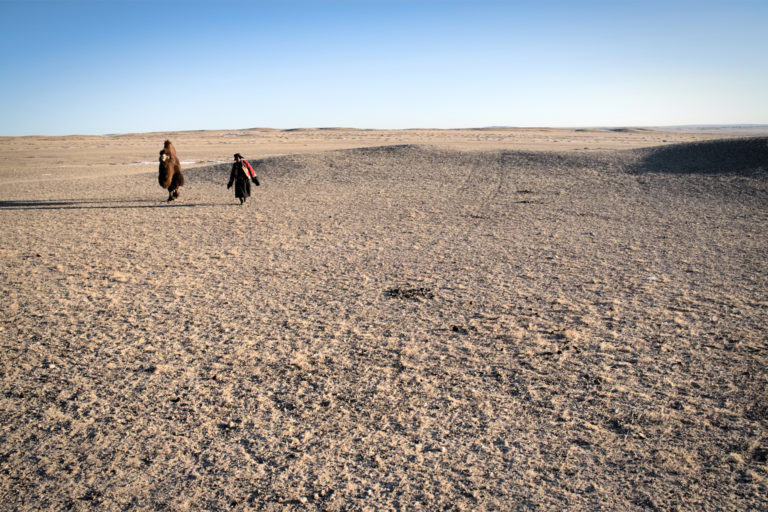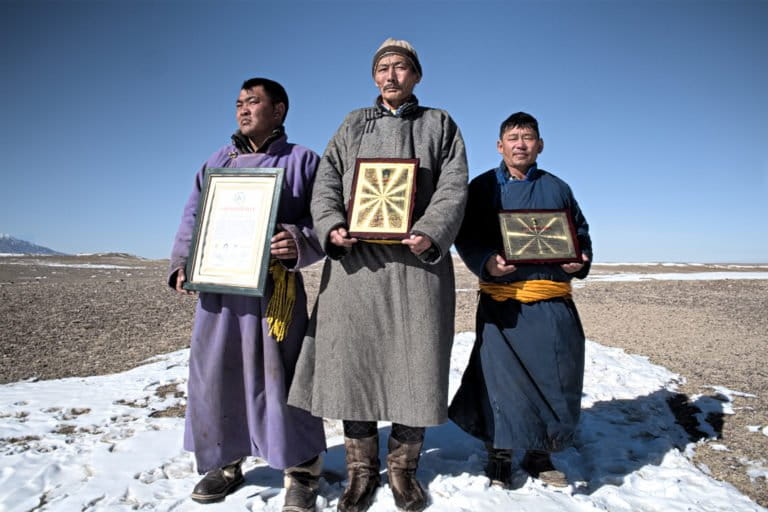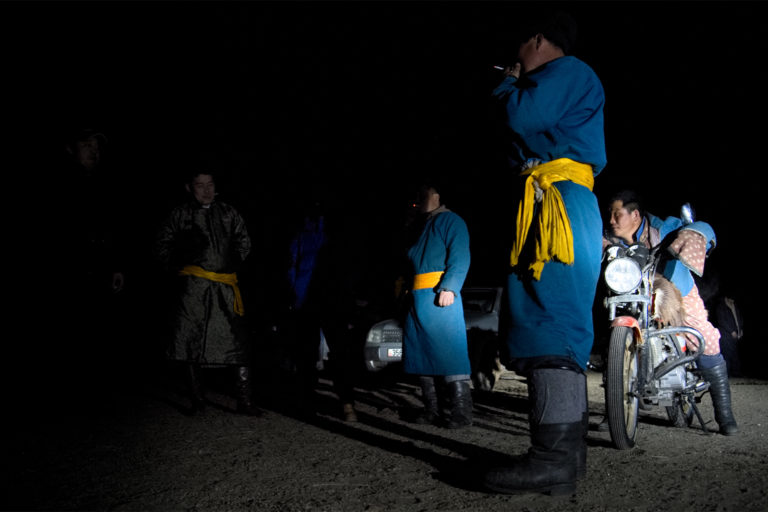- Rangelands and the pastoralists who rely on them are an overlooked and understudied part of global conservation.
- Tunga Ulambayar, country director for the Zoological Society of London’s Mongolia office, says she wants to change this by complementing the scientific understanding with pastoralists’ traditional knowledge of nature.
- “There is no university teaching that kind of traditional knowledge, but if we really aim to care about these regions and their resources, even from an economic perspective, we need this knowledge,” she says.
- Ulambayar also notes that pastoralism, widely practiced in less industrialized countries, is increasingly recognized as an efficient system of resource management and a resilient culture.

Vast terrains dominated by grasses, shrubs or sparse trees, rangelands are more than unproductive places where reticent herders graze their livestock and wildlife browse dry — or green, if lucky — meadows. They host about a quarter of Earth’s human population, provide forage to some 75% of domesticated livestock, and contribute to economies, especially in less industrialized countries. Yet, their potential for mitigating climate change is generally undervalued.
After decades of underestimating the role of local peoples, if not neglecting their knowledge altogether, scientists are increasingly including traditional ecological knowledge in their assessments. With her team, a Mongolian ecologist is at the forefront in this change.

Rangelands, a landscape dominated by uncertainties
Prairies, steppes, desert shrublands, savannas and tundras — the various types of rangelands — cover about 40% of the Earth’s continental area, not including Antarctica. They also store some 10-30% of global carbon in Earth’s soils.
But some rangelands are under threat. Scientists warn that the Mongolian steppe is creeping toward an ecological and cultural tipping point. Climate change together with increased livestock and grazing are inducing plant species shifts and loss. Though irreversible degradation thresholds have not yet been crossed, there is an urgent need for reducing pressures and supporting local economies to adapt to changes.
Tunga Ulambayar, country director of the Mongolian office of the Zoological Society of London (ZSL), has pioneered environmental conservation in Mongolia since the early 1990s, when the nation transitioned from a socialist to a market economy. She is currently involved in research and monitoring projects on pastoral community institutions, community-based natural resource management and wildlife conservation.
Her challenge is merging quantitative scientific data with qualitative traditional ecological knowledge, engaging communities who actually use and witness changes on local resources: herders and other rural people spread across the vastness of Mongolia. Mixing graphs, surveys, and herders’ perceptions is not an easy task, but Ulambayar says it’s the key to conserving the ecosystems and their services to humans.
Home to several types of rangelands, Mongolia exists at the crossroads between the central Asian steppe, the Siberian taiga and the Gobi Desert. To the west, the Altai Mountains form a natural border with western Central Asia.
Most of the world’s population today lives in cities. Ulambayar says this has led to a disconnect between the city and the countryside, and a growing misperception that the latter regions are essentially uninhabited and unproductive. Healthy rangelands, she says, “supply goods that are necessary for the livelihood and safekeeping of some 2 billion people on Earth,” providing food, raw materials and fuel, as well as security from natural disasters.

For the pastoral people who call rangelands home, life has always been marked by uncertainty. Will the rains come this year? How long will the winter last? Pastoral people, Ulambayar says, have evolved to survive in these conditions, and to thrive; in Mongolia, their livelihoods contribute to the national economy in the form of meat and cashmere production and tourism. “From an economic perspective, it is a very efficient kind of system,” she says. “It is an extraordinarily resilient culture. This was only recently acknowledged by experts.”
Grasslands are more efficient carbon sinks than one may think, with carbon stored in the soil as well as in the plants growing there. Grasslands and steppes recover faster than forests from droughts and fires, which are projected to become more common as the planet warms.
But in Mongolia, temperatures are rising as fast as anywhere on Earth, with major consequences for rangelands and pastoralism. Rising temperatures bring more frequent droughts and melting permafrost. Decreasing snow and rain prevent herders from staying as long as they used to in winter areas. Weather disasters such as forest fires and dzuds, snow storms that occur at extremely low temperatures, further imperil their existence.
Such changes have an influence on social and economic issues, such as overgrazing, or the increasing value of some exported products such as cashmere, Mongolia’s most valuable commodity after mineral exports.

Where traditional ecological knowledge may support science
Mongolia is huge — four times the size of California. Habitats, wildlife and environmental changes are not easy to study and monitor. Research centers are sparse and infrastructure is limited. It’s here where Ulambayar’s team comes in, as she tries to integrate scientific knowledge with traditional ways to assess landscapes and resources. Ulambayar has long maintained that dialogues between pastoral people, scientists and policymakers can contribute to a profound knowledge.
In more densely populated areas, institutions send people around surveying plants, wildlife and landforms. In sparsely populated regions, pastoral people are observing land transformations, soil, water, biodiversity degradation all the time. Ulambayar says making use of their eyes and their knowledge is a solution for monitoring and surveying.

“We use what we call participatory problem analysis, which is quite a scientific method,” she says. “It collects everyone’s perspectives, knowledge, experience. The scientists and the herders. In short, we bring all people, the families, in a ger and we ask them to map their grazing area. Everybody is invited to participate. We ask them to map the winter camp, the main rivers, the summer grazing areas, and resources.”
That wealth of collective knowledge then goes into populating maps with details that to the untrained eye may seem like nothing more than grass, shrubs and some dust.
This involves a process of talking with local leaders and organizing a meeting in a ger in the Mongolian steppe with herders from miles away. The researchers reach the meeting point on motorbike or horseback, drink a suutei tsai, the typical salty mik tea, then instruct the herders on basics of ecology, and let them map their resources and natural features of the land.
“By bringing all these people together, we also understand their perception of resources, what is of value, what they feel is degrading or improving,” Ulambayar says. Areas that seem resource-poor on scientists’ aerial photographs, for example, might actually contain rich grasses, something only the herders will know. “If the goal is conservation, this is the information you need as an ecologist or planner.”

Nomadic people hold a special knowledge of their landscape, which is transmitted informally. “They know where to go, when to go, what sort of plants the camels or goats like,” Ulambayar says. “It is an informal way to pass a knowledge about the resources. There is no university teaching that kind of traditional knowledge, but if we really aim to care about these regions and their resources, even from an economic perspective, we need this knowledge.”
If Ulambayar’s team plants forage plants over a large area, for example, the herders can tell them where the planting was successful and where it was not. “We can monitor what changes are happening due to people’s actions or climate-related events,” she says. It’s citizen science, with the herders taking the lead.
Pastoral people are helping not only to monitor the environment, but also in wildlife conservation projects, for example by patrolling their territories. In mountainous central Mongolia, where deer, falcons and some plant species are illegally poached and harvested, ZSL is funding herders to protect endangered wildlife.

Since locals have been involved in the poaching, Ulambayar has met with them and discussed the values and fragilities of their natural resources. By being involved in environmental conservation, herders and nomads have found a scope in guarding their territories. “We generated a change of attitude, they became guardians of their own land and resources,” Ulambayar says.
It’s time to recognize the value of traditional ecological knowledge, she says. “That’s why we are asking for an International Year of Pastoralism,” she says. “There is the perception that pastoralism is not modern, it’s a relic of an old world. But scientists are now saying that this is a very efficient form of management of resources, and contributes in particular to less industrialized economies. After all, 90% of pastoral systems are in developing countries.”
The Mongolian steppe is a hotspot, where the dialogue between scientific and traditional ecological knowledge is starting to take shape.
Banner image: Nomadic life is decreasing in Mongolia, but it is still a backbone for the country’s culture and economy. Image by Jacopo Pasotti for Mongabay.
